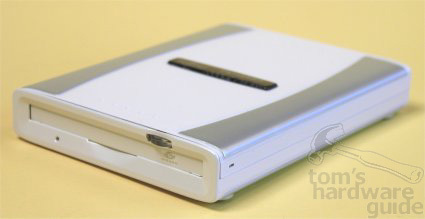Magneto-Optical Storage: Fujitsu DynaMO 1300 Pocket
Magneto-optical Data Storage (MO)
How Fujitsu touts its own MO technology.
The technology's birth lies way back in the past to 1957, when efforts were made to save and read out data using focused electron beams. Only with the advent of the laser could the concept be developed further.
Magneto-optical technology began to be used to archive data in the late 1980s. In contrast to magnetic storage technology, MO first requires a heated surface to write in order to destroy the precious metal's polarization. Only then can it be written to. Reading is performed optically only, which explains the stark divergence between read and write speeds.
The Fujitsu DynaMO 1300 U2 Pocket MO Guinea Pig
The DynaMO 1300 U2 Pocket is compact and ultra-slim - measuring 16 x 12 x 3.4 cm and is as big as a desktop hard drive. Its weight of 630g makes the drive seem heavier than expected.
Thus the DynaMO is not all that suitable for lugging around regularly - even if its low energy rating of 5.5 watts tops means that it can draw its power via the USB port.
Versions with ATAPI interface (MCM3130AP) and SCSI (MCM3130SS) are also available for the DynaMO U2 Pocket; the DynaMO 1300SF is an external model with SCSI interface. As has traditionally been the case, SCSI versions are far more expensive compared to ATAPI and USB interfaces.
Admittedly, the version we tested with USB 2.0 interface is best suited as a multi-purpose device since the small universal port is found on practically every x86-compatible computer - from notebooks right up to rack mount servers.
Get Tom's Hardware's best news and in-depth reviews, straight to your inbox.
A small stand is also included, meaning that the DynaMO 1300 U2 Pocket can be stowed quickly and unobtrusively next to the monitor.
Current page: Magneto-optical Data Storage (MO)
Prev Page Fujitsu DynaMO 1300 U2 Pocket Next Page The Fujitsu DynaMO 1300 U2 Pocket MO Guinea Pig
Patrick Schmid was the editor-in-chief for Tom's Hardware from 2005 to 2006. He wrote numerous articles on a wide range of hardware topics, including storage, CPUs, and system builds.



